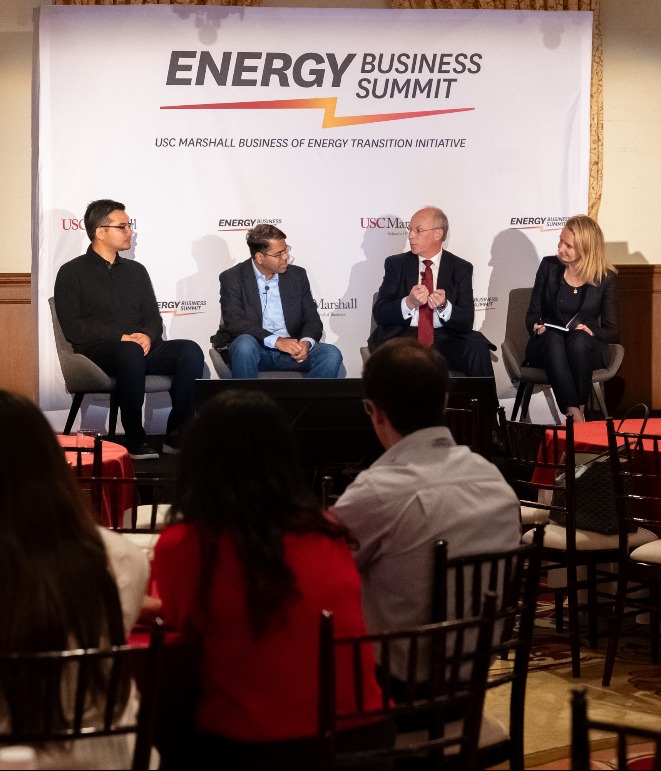
Quoted: Nathanael Fast in BBC
Fast explains that Australia's social media ban for children under 16 could be a proof of concept for other countries to do the same.
USC Marshall Hosts Inaugural Energy Business Summit
USC Marshall Hosts Inaugural Energy Business Summit
The Zage Business of Energy Transition Initiative gathered global business leaders and academics to discuss the future of energy innovation and transformation.

The Times reporter Louisa Clarence-Smith moderates the panel on AI and data-center energy demands featuring (L-R) Asher Genoot '14, Anand Mohanrangan, and Joseph A. Householder '78.
[USC Photo / Christopher Frazier]
“Energy is the cornerstone of modern progress.”
That statement set the tone as Shon Hiatt, the director of USC Marshall’s Zage Business of Energy Transition Initiative (BET), opened the inaugural Energy Business Summit on October 15 at the Town and Gown. More than 250 guests, industry executives, global business leaders, and academics, as well as students from the graduate Marshall Energy and Sustainability Club and the undergraduate Marshall Energy Business Club, attended the day-long event focused on the opportunities and challenges associated with energy innovation and transformation.
The BET Initiative was founded last fall with the goal to advance research, experiential learning, and strategic partnerships related to the role of business in transitioning to sustainable energy systems. The summit sought to explore methods in balancing the current energy landscape with the needs of sustainability goals.
“The real progress will occur in the business offices, the laboratories, and manufacturing hubs where risks are taken, investments are made, and game-changing technologies are scaled,” Hiatt remarked in his welcome address.
USC Marshall Dean Geoffrey Garrett echoed the purpose of the initiative and the summit that each prioritize the need for a balanced energy strategy. He emphasized that the global mandate must work toward measurable and sustainable energy goals of security, safety, affordability, and cleanliness.
“The energy transition challenges in the world are immense and it’s going to be technological innovation that solves energy challenges, not government regulation,” Garrett said.
The summit hosted five panels comprising industry leaders from the mining and metals, wind, hydrocarbon, hydrogen, and natural gas and liquefied natural gas (LNG) sectors, with two additional panels featuring leading voices on energy finance and energy demand.
Energy production and consumer consumption, particularly with the rise of data-centers, add layers to an already complicated matrix to reduce emissions. Switching to EVs? Coal is the largest source of electricity. Proponent of onshore wind farms? Upgrades are needed to an aging and unstable energy grid.
While Garrett and Hiatt highlighted the opportunities of the energy transition, the guest speakers, with their boots-on-the-ground perspective, focused on the realities they navigate daily in their industries. The room consensus held that the next breakthroughs in energy will require political determination, visionary innovators, and corporate leaders working in tandem across energy sectors and nations. Needless to say, it will require a lot of capital.
“The day of cheap energy is at a close,” remarked William La Jeunesse, a Fox News Channel correspondent and the panel moderator for the energy finance session.
The honest dialogue focused not on where the world is going in terms of sustainability, but how the industry gets there. Innovation and investment are key, but speakers also pressed on the need for smart regulation, permitting reform, government collaboration, consistent trade policy, and infrastructure improvements to help spur energy transformation.
The real progress will occur in the business offices, the laboratories, and manufacturing hubs where risks are taken, investments are made, and game-changing technologies are scaled.
— Shon Hiatt
Director of Zage Business of Energy Transition Initiative
“I think there are lots of people who want to deploy capital to the infrastructure business … infrastructure itself is a great long term investment,” remarked Wil VanLoh, CEO and founder of Quantum Capital Group.
The basis for all energy comes from materials that must be mined and produced. Whether it’s gas for cars, batteries for mobile phones, or steel for wind turbines, critical minerals such as aluminum, lithium, copper, and other materials are vitally important to enable the transition.
Jesse E. Gary, president, CEO, and director of Century Aluminum, explained the desperate role of aluminum in the solar and EV industries across the globe. In China alone, they have experienced a 40% aluminum demand increase for EVs and another 20% increase year over year just for energy distribution.
“When you look at EVs and you look at distributed energy in general, you start to see and start to calculate just how much more material intensive these industries are than the traditional gas turbine or a coal power station,” Gary continued.
One of the cleanest forms of energy is wind. While offshore wind may take 5–10 years to develop from concept to production, onshore wind has the potential to ramp up more quickly by taking advantage of local grids and power systems. Clint Plummer, CEO of Rise Light & Power, says wind plays an important part of that solution, but it’s not the silver bullet. The cost of capital and supply chain issues hinder development. However, Plummer thinks smart government policies and an open competitive marketplace will affect the most responsible energy transition.
“We think that’s the right type of market where it’s an open competition, where the policymakers are identifying reliability needs, where they’re appropriately valuing the energy, the capacity, and the environmental attributes,” Plummer explained. “That’s a much more effective use of public policy than only throwing additional [federal tax] incentives or economics toward projects.”
VanLoh spoke to the incentive benefits of the Inflation Reduction Act on clean energy, but also noted in his keynote speech the need for planning on a wider scale.
“We really do need a Manhattan project in the U.S. to reestablish the United States as the preeminent leader, because we have the technology and the ability to bring manufacturing jobs back,” VanLoh said.
While artificial intelligence (AI) was a topic throughout many of the sessions, one panel focused entirely on the technology’s immense demand for energy consumption.
Examining AI’s role on data center dynamics, guest panelists discussed the shift toward GPU power, the challenges of escalating power consumption, and the necessity for advanced cooling technologies.
Anand Mohanrangan, a partner at McKinsey & Company, indicated that projected data center capacity will grow from 55 gigawatts to between 155 and 290 gigawatts before 2030; 70% of that capacity will be AI-driven workloads.
The search to fuel those data centers is already heating up as Microsoft plans to restart Three Mile Island while Google is partnering with Kairos Power. The demand to find power sources for AI will be an endless pursuit in the next one to two years, according to Asher Genoot ’14, the CEO of Hut 8 Corp.
When asked what type of power will companies seek next, Genoot answered, “Any source of power they can get their hands on.”
People power was also an indirect topic of the summit and the immense competition for talent.
Paul Flynn, managing director/CEO of Whitehaven Coal, spoke of the need for upcoming leaders in the energy industry from engineers to finance to governance and essentially assured students’ future from a career perspective.
“This area requires lots of intelligent, driven, smart minds to be devoted to the solutions that we require over time,” Flynn declared. “If we’re going to meet those [lower emissions] goals, then we’re going to need a lot more people than what the old folks here up on stage are doing.”
As the summit came to a close, Darpan Kapadia, the COO of LS Power, and a major funder behind the creation of BET, remarked how the world is at a unique crossroads as large parts of the planet are trying to “industrialize and decarbonize” at the same time.
“There’s two transitions happening simultaneously, and that’s going to put enormous strains on the availability of capital, the availability of labor, supply chains, and the like,” Kapadia said. “And because we’re trying to build new energy ecosystems on top of existing ones, it’s an enormous task.”
A task made less daunting, perhaps, when diverse voices, experiences, and perspectives discuss the challenges and opportunities in deliberative ways.
RELATED
Quoted: Nathanael Fast in BBC
Fast explains that Australia's social media ban for children under 16 could be a proof of concept for other countries to do the same.
Cited: Shon Hiatt in E&E News
Shon Hiatt quoted, "It is not surprising that gas is getting a boost as AI deals get larger and technology companies look for around-the-clock power."
Quoted: Cheryl Wakslak in Fast Company
Wakslak explains how exclamation point usage in emails doesn’t affect perceptions of confidence, contrasting with researchers’ assumptions.
Marshall Faculty Publications, Awards, and Honors: November 2025
We are proud to highlight the many accomplishments of Marshall’s exceptional faculty recognized for recently accepted and published research and achievements in their field.
Interview: Marco Aponte-Moreno in KCBS
Aponte-Moreno discusses the tense situation between the United States and Venezuela and the prospect of a possible regime change in the South American country.